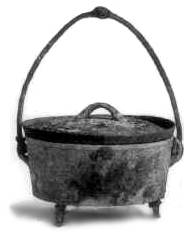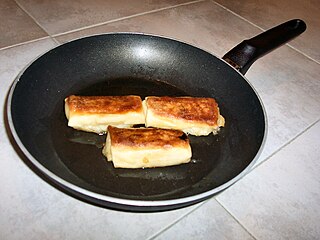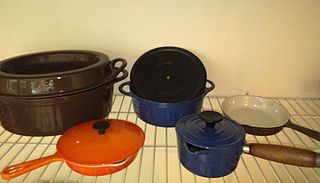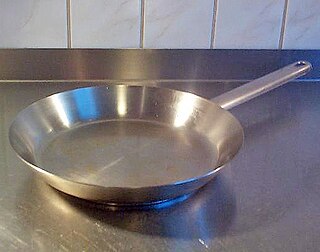
A wok is a deep round-bottomed cooking pan of Chinese origin. It is believed to be derived from the South Asian karahi. It is common in Greater China, and similar pans are found in parts of East, South and Southeast Asia, as well as being popular in other parts of the world.

Cookware and bakeware is food preparation equipment, such as cooking pots, pans, baking sheets etc. used in kitchens. Cookware is used on a stove or range cooktop, while bakeware is used in an oven. Some utensils are considered both cookware and bakeware.

A Dutch oven or casserole dish (international) is a thick-walled cooking pot with a tight-fitting lid. Dutch ovens are usually made of seasoned cast iron; however, some Dutch ovens are instead made of cast aluminum, or ceramic. Some metal varieties are enameled rather than being seasoned, and these are sometimes called French ovens. The international name casserole dish is from the French casserole which means "cooking pot". They are similar to both the Japanese tetsunabe and the sač, a traditional Balkan cast-iron oven, and are related to the South African potjie, the Australian Bedourie oven and Spanish cazuela.

A kitchen stove, often called simply a stove or a cooker, is a kitchen appliance designed for the purpose of cooking food. Kitchen stoves rely on the application of direct heat for the cooking process and may also contain an oven, used for baking. "Cookstoves" are heated by burning wood or charcoal; "gas stoves" are heated by gas; and "electric stoves" by electricity. A stove with a built-in cooktop is also called a range.

Induction cooking is performed using direct electrical induction heating of cooking vessels, rather than relying on indirect radiation, convection, or thermal conduction. Induction cooking allows high power and very rapid increases in temperature to be achieved: changes in heat settings are instantaneous.

Corning Ware, also written CorningWare, was originally a brand name for a unique glass-ceramic (Pyroceram) cookware resistant to thermal shock. It was first introduced in 1958 by Corning Glass Works in the United States. The brand was later spun off with the sale of the Corning Consumer Products Company subsidiary.

Le Creuset is a French-Belgian maker of cookware. They are best known for producing enameled cast-iron cookware. The company first manufactured their products in the town of Fresnoy-le-Grand in France in 1925, which are similar in function to a Dutch oven but with T-shaped handles. The Le Creuset Dutch oven is on display in the Smithsonian Institution's National Museum of American History in Washington, D.C. as a part of the recreation of the chef Julia Child's kitchen. It has been widely reported to be her favorite cooking pot, though specialist sources hold that it was the Dutch oven of Le Creuset's less-remembered competitor Descoware that was her real favorite. The company also makes many other types of cookware and bakeware, from fondue-sets to tagines.

Heavy-duty cookware made of cast iron is valued for its heat retention, durability, ability to maintain high temperatures for longer time duration, and non-stick cooking when properly seasoned. Seasoning is also used to protect bare cast iron from rust. Types of cast-iron cookware include frying pans, dutch ovens, griddles, waffle irons, flattop grills, panini presses, crepe makers, deep fryers, tetsubin, woks, potjies, and karahi.

A non-stick surface is engineered to reduce the ability of other materials to stick to it. Non-stick cookware is a common application, where the non-stick coating allows food to brown without sticking to the pan. Non-stick is often used to refer to surfaces coated with polytetrafluoroethylene (PTFE), a well-known brand of which is Teflon. In the twenty-first century, other coatings have been marketed as non-stick, such as anodized aluminium, silica, enameled cast iron, and seasoned cookware.

A kitchen utensil is a small hand-held tool used for food preparation. Common kitchen tasks include cutting food items to size, heating food on an open fire or on a stove, baking, grinding, mixing, blending, and measuring; different utensils are made for each task. A general purpose utensil such as a chef's knife may be used for a variety of foods; other kitchen utensils are highly specialized and may be used only in connection with preparation of a particular type of food, such as an egg separator or an apple corer. Some specialized utensils are used when an operation is to be repeated many times, or when the cook has limited dexterity or mobility. The number of utensils in a household kitchen varies with time and the style of cooking.

Cousances was a brand of enameled cast iron cookware. originally manufactured by a foundry in the town of Cousances-les-Forges in northeastern France. The Cousances foundry began making cast iron pans in 1553. Four centuries later, in 1957, the brand was acquired by Le Creuset. Cookware under the Cousances brand continued to be manufactured by Le Creuset into the early 1980s.

Revere Ware is a line of consumer and commercial kitchen wares introduced in 1939 by the Revere Brass & Copper Corp. The line focuses primarily on consumer cookware such as skillets, sauce pans, stock pots, and tea kettles. Initially Revere Ware was the culmination of various innovative techniques developed during the 1930s, the most popular being construction of stainless steel with rivetlessly attached bakelite handles, copper-clad bases and rounded interiors for ease of cleaning. Over the next 40+ years, Revere Ware would introduce new series to position itself in competition with other manufacturers at various price points, or for specific specialty markets. In the early 1960s the profitability of Revere Ware began to level off. Coinciding with new series introductions, cost-cutting measures were implemented in the manufacture of the traditional cookware. The bakelite handles were changed from two piece to one, and the thickness of utensil walls and copper cladding were reduced.

A frying pan, frypan, or skillet is a flat-bottomed pan used for frying, searing, and browning foods. It is typically 20 to 30 cm in diameter with relatively low sides that flare outwards, a long handle, and no lid. Larger pans may have a small grab handle opposite the main handle. A pan of similar dimensions, but with less flared, more vertical sides and often with a lid, is called a sauté pan. While a sauté pan can be used as a frying pan, it is designed for lower-heat cooking.

Seasoning is the process of coating the surface of cookware with fat which is heated in order to produce a corrosion resistant layer of polymerized fat. It is required for raw cast-iron cookware and carbon steel, which otherwise rust rapidly in use, but is also used for many other types of cookware. An advantage of seasoning is that it helps prevent food sticking.

Julia Child's kitchen is a historic artifact on display on the ground floor of the Smithsonian Institution's National Museum of American History: Kenneth E. Behring Center, located in Washington, D.C., on the National Mall. The kitchen is not a replica, but is the actual kitchen used by noted 20th-century cookbook author and cooking show host Julia Child, appearing as the backdrop to several of her television shows.

Druware, also known as DRU Holland cookware and Royal Dru, was a line of porcelain-enamel-coated cast-iron cookware made by the De Koninklijke Diepenbrock & Reigers of Ulft (DRU) company in Achterhoek, Netherlands.

Griswold Manufacturing was an American manufacturer of cast-iron kitchen products founded in Erie, Pennsylvania, in business from 1865 through 1957. For many years the company had a world-wide reputation for high-quality cast-iron cookware. Today, Griswold pieces are collectors' items.
Visions is a brand of transparent stove top cookware created by Corning France and introduced to Europe during the late 1970s. In 1983, it was introduced in the United States and became the number one selling cookware set for a number of years. Visions is made of a transparent material belonging to the Pyroceram family of glass-ceramics. It is one of the few cookware lines that can be used on the range, in the oven, and under a broiler. It will withstand heat up to 850 °C (1,560 °F) with thermal traits similar to Corning Ware plus improved resistance to staining and the detrimental effects of acids and detergents. Visions is sold worldwide by Instant Brands.

















